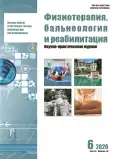Comparison of the effectiveness of treatment and the effect on the composition of the microbiota in patients with acne when using isotretinoin monotherapy and its combination with phototherapy with broadband incoherent light
- Authors: Kolodiy A.A.1, Kruglova L.S.1, Gryazeva N.V.1
-
Affiliations:
- Central State Medical Academy of the Presidential Administration of the Russian Federation
- Issue: Vol 19, No 6 (2020)
- Pages: 371-379
- Section: Original studies
- URL: https://journal-vniispk.ru/1681-3456/article/view/78550
- DOI: https://doi.org/10.17816/1681-3456-2020-19-6-4
- ID: 78550
Cite item
Abstract
Background. Laser and LED light sources operating in the range of 400–700 and 800–1400 nm can affect the links of the pathogenesis of acne (they destroy the pathogenic bacterial flora and lead to atrophy of the sebaceous glands due to heating of the vessels feeding the glands, which ultimately reduces the production of sebum) and can be very effective in the treatment of patients with acne.
Aims: To evaluate the effectiveness of the combination of incoherent broadband light (IPL) and low doses of systemic isotretinoin compared with standard isotretinoin monotherapy, as well as the effect on the composition of the microbiota in patients with acne.
Materials and methods. 78 patients with a diagnosis of acne, papulo-pustular form, moderate severity were monitored on an outpatient basis. Depending on the method of therapy, patients are divided into 2 groups. The dermatological status of patients was assessed taking into account the dermatological index GSS (Global Severity Ssore), the dermatological index of acne (DIA), the IGA scale (Investigator's Global Assessment), the quality of life index (QOL). To study the composition of the skin microbiota in all patients before and after therapy, an analysis was performed using the method of chromatography-mass spectrometry of microbial markers.
Results. Both methods are effective, but according to the global scale of severity (GSS), clinical remission was significantly more frequent in the combination therapy group compared to the motor therapy group (88 and 74%, respectively, p <0.05). In addition, in the group of patients who received the combined method of treatment, there was a more pronounced positive dynamics of DIQH compared to the group of patients who received monotherapy — 76 and 84%, respectively (at p <0.05, compared with the indicators before treatment). After treatment, there was a pronounced positive dynamics and normalization of most indicators of the microbiota of the skin of the face, but the number of some targeted microorganisms was slightly higher than normal after therapy.
Conclusions. Thus, the combined treatment with IPL and low doses of systemic isotretinoin is a safe and effective method of treating moderate acne.
Full Text
##article.viewOnOriginalSite##About the authors
Anastasia A. Kolodiy
Central State Medical Academy of the Presidential Administration of the Russian Federation
Email: tynrik@yandex.ru
ORCID iD: 0000-0002-2944-0232
SPIN-code: 7644-0893
Russian Federation, Moscow
Larisa S. Kruglova
Central State Medical Academy of the Presidential Administration of the Russian Federation
Email: tynrik@yandex.ru
ORCID iD: 0000-0002-5044-5265
SPIN-code: 1107-4372
MD, Dr. Sci. (Med.)
Russian Federation, MoscowNatalia V. Gryazeva
Central State Medical Academy of the Presidential Administration of the Russian Federation
Author for correspondence.
Email: tynrik@yandex.ru
ORCID iD: 0000-0003-3437-5233
SPIN-code: 1309-4668
Cand. Sci. (Med.)
Russian Federation, MoscowReferences
- Bakulev AL, Kravchenya SS, Platonova AN, Igonina IA. Long-term therapy of patients with severe acne: the choice of doses and regimens of systemic isotretinoin. Bulletin of Dermatology and Venereology. 2014;(1):81–88. (In Russ).
- Leyden JJ, Del Rosso JQ, Baum EW. The use of isotretinoin in the treatment of acne vulgaris: clinical considerations and future directions. Journal of Clinical and Aesthetic Dermatology. 2014. Vol. 7, N 2, Suppl. P. S3–S21.
- Kircik LH. Evaluating tretinoin formulations in the treatment of acne. Journal of Drugs in Dermatology. 2014;13(4):466–470.
- Mobacken H, Sundström A, Vahlquist A. 30 years with isotretinoin. "Miracle medicine" against acne with many side effects. Lakartidningen. 2014;111(3-4):93–96. (In Swedish).
- Batkaev EA, Molodova YuS. Low doses of isotretinoin (aknecutan) in the treatment of resistant forms of acne. Bulletin of Postgraduate Medical Education. 2012;(1):47–48. (In Russ).
- Bakurova VA. Photodynamic therapy of acne. Bulletin of Postgraduate Medical Education. 2012;(2):386–388. (In Russ).
- Bowe W, Kober M. Therapeutic update: acne. Journal of Drugs in Dermatology. 2014;13(3):235–238.
Supplementary files
















